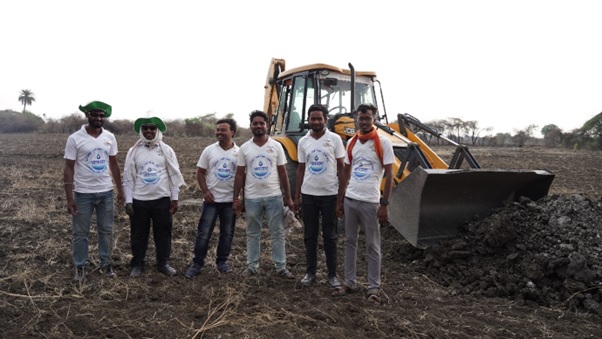Testimonials
When I came to know about the benefits of JalTara, I decided to implement it on my farm. It has prevented waterlogging and preserved groundwater for a longer time.

Krishna Takle
Farmer, Pokhari Village, Jalna District
Under JalTara Yojna, recharge structures were constructed on my farm. Usually, during the summer season, we experience drought problems, but this time there is enough water available for farming all year long.

Digambar Baburao Takle
Farmer, Manta Taluka, Jalna District
After the implementation of the JalTara Project, the water level in my area has increased.

Gyaneshwari Kakde
Farmer, Manta Taluka, Jalna District
Before JalTara Yojna no effort was made to conserve water. After the implementation of JalTara Yojna, we have plenty of water in our hand pumps.

Suman Bai
Farmer, Murumkheda Village
Our village, Shivangiri, benefited from the JalTara Project. This strategy has raised groundwater levels and doubled our income. Today, farmers are happy.

Madan Pandrinath Jadhav
Farmer, Jalna District
In the framework of the JalTara project, we built recharge shafts close to wells. After the very first rain, we discovered that the water level had risen to 75%. The JalTara project is an excellent way to end water scarcity and should be implemented by everyone to increase groundwater.

Mahadev Nivratti Narvade
Farmer
JalTara prakalpa was started in our village last year. I want all the farmers to know about its benefits. Since we live in a mountainous region, the water levels in our village were very low. We dug many wells in our village, but none provided water.
The implementation of JalTara in our village benefited us in two ways: first, it increased water levels, and second, the land, which previously turned muddy due to rain, now remains dry as the water is absorbed by the recharge structures.
Every farmer should implement this project in their village.

Balasaheb Bahekar
Farmer, Jalna District
I had 6 acres of land, of which one acre produced crops. Previously, there was mud after rains. After the construction of JalTara recharge structures, the water level in my well has risen. I can grow more crops now.

Appasaheb Bahekar
Farmer, Jalna District
I have been farming for two years. JalTara came into existence in our village last year. I own 32 acres of land for farming where 40 JalTara recharge structures were constructed. Earlier, where there were 8-10 crore crops, now the land is producing 13-14 crore crops every year.

Narayan Vaidyanath Dighe
Farmer, Ambora, Jahangir Village
Our village's water situation deteriorated after the rains because the mud was everywhere. We needed more water to grow crops. After JalTara's implementation, the situation has improved as all the rainwater goes into recharge structures. Now there is no mud, and water levels have risen.

Balasaheb Lomte
Farmer, Jalna District
JalTara's technique benefited us. We didn't have to spend anything to implement the JalTara technique on our farm and reaped immediate benefits after recharge structures were constructed next to our wells as the water levels doubled.

Vikas Hamre
Farmer, Warud Village
Due to JalTara recharge structures, water levels in the well of my village have increased. I recommend that all the farmers in other villages should implement the JalTara technique on their farms.

Baburao Jaivanto Kakde
Farmer, Jaipur Village (MH)
I was hesitant to bring JalTara onto my farm because the water levels in my well were low during the summer and it was muddy everywhere during rains. In the years 2021–2022, the construction of JalTara recharge structures helped absorb the excess water in the soil and raised water levels in wells. Everyone should implement these to see the results.

Sugan Nitnavre
Farmer, Shivangiri Village (MH)
Earlier, there was too much mud on the farm. Excess water was soaked after constructing JalTara recharge structures. Water levels in my wells have increased. Soybean & chana crops production optimized.

Sulabai Chavhal
Farmer, Murumkheda Village (MH)
After JalTara recharge structures are constructed, crop yield has doubled. Earlier, we used to run the motor for two hours but still had no water. After the construction of JalTara recharge structures, the water level has now increased in the summer too.
I have been farming for 15 years. Due to a lack of water, crop production was very low, but now, after the implementation of JalTara, the crop yield has doubled. I believe the JalTara project will benefit all Maharashtra talukas and districts.

Appasaheb Chauhan
Farmer, Jalna District
Earlier, one of my wells dried up and was not in use. I implemented JalTara on my farm, but neighbouring farms faced the problem of excessive mud. After seeing me, they also implemented JalTara recharge structures, which led to an increase in 14 quintals of soybean yield.

Ashok Ambure
Farmer, Jalna District
Previously, 90% of the houses in this area were made of mud. Currently, 60 to 70 % of houses are built of concrete, and the remaining ones will be finished within a year. When I finish building my house, I'll give it the name 'JalTara'

Nivritti Kisarao Palve
Farmer, Palashkheda Village, Jalna










